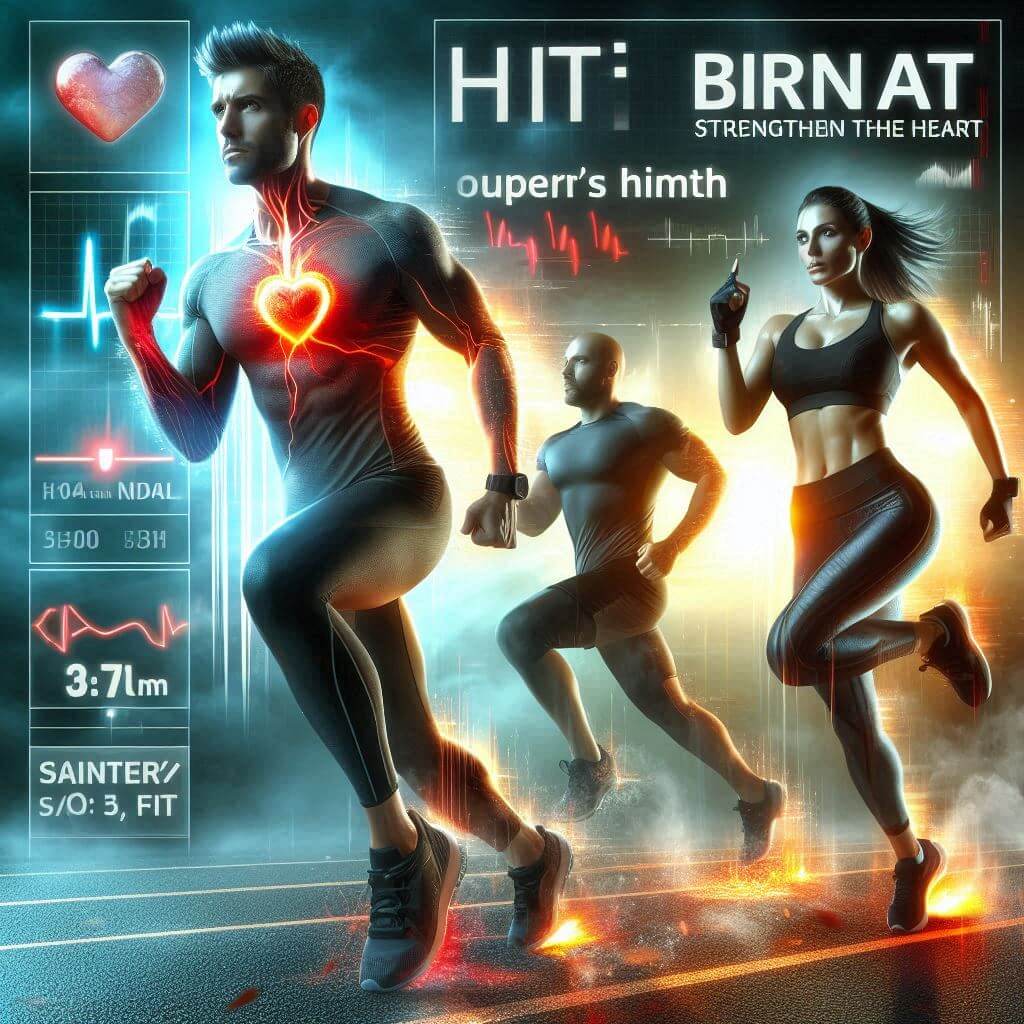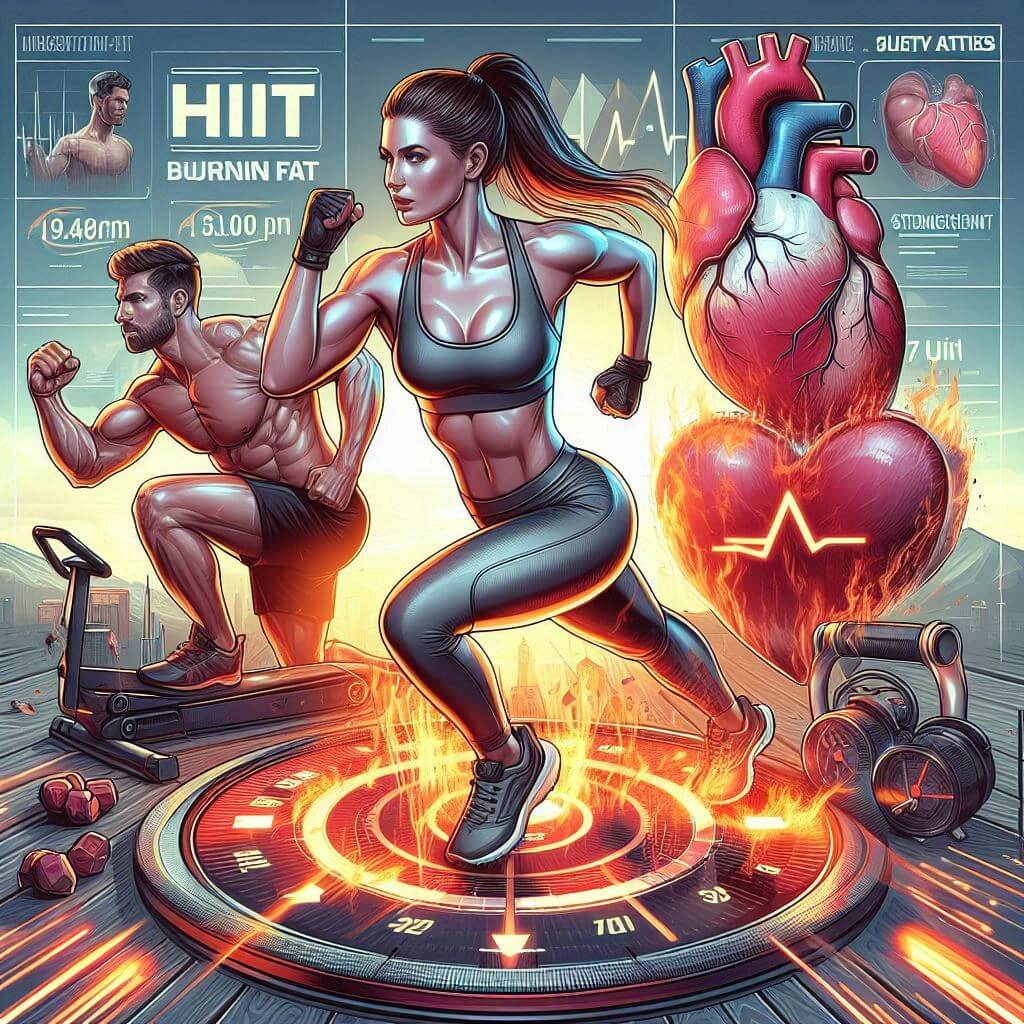Tired of boring workouts with no results? HIIT (High Intensity Interval Training) is here to revolutionize your fitness routine and take you to the next level!
More than just burning calories, this innovative modality helps you achieve a strong body, a healthy heart and a more balanced mind, all in short and highly effective sessions.
Unlock the Secrets of HIIT:
Imagine a workout that combines bursts of intense physical activity with short recovery breaks.
This is the essence of HIIT, where you push yourself to your limits for short periods and then slow down to catch your breath.
This strategic alternation raises your heart rate, activates several muscle groups and triggers a calorie-burning process that continues even after your workout!
General information about HIIT:
Burning Fat with Turbo Efficiency:

HIIT is the secret weapon for those who want to eliminate fats unwanted and achieve a defined body.
During high-intensity exercise, your body goes into “fat burning” mode, using stored fat as its main source of energy.
But it doesn't stop there! EPOC (Excess Post-Operational Oxygen Consumption)Exercise) springs into action, raising its metabolism for hours after training, burning even more calories and bringing you closer to your goals.
A Strong Heart for a Better Life:
HIIT isn’t just about burning calories. It’s a true cardiovascular workout that strengthens your heart, improves blood circulation, and increases your physical endurance.
With HIIT, you will have more energy for your daily activities, you will climb stairs without getting tired and you will be ready to face any challenge.
More than a Strong Body, a Balanced Mind:
The benefits of HIIT go beyond the physical and directly impact your mental health.
Studies show that this practice reduces stress, anxiety and symptoms of depression, in addition to improving mood, sleep quality and self-esteem.
HIIT helps you feel more energetic, positive and ready to face life's challenges with more ease and energy.
Workouts for All Levels:
Whether you’re a beginner or an experienced fitness enthusiast, HIIT can be tailored to your needs.
For beginners, short workouts with low-intensity intervals are the gateway to this universe.
Experienced practitioners can explore more intense and longer exercises, challenging their limits and enhancing their results.
Recipes for a Delicious HIIT:
- Heating: Prepare your body for action with 5 to 10 minutes of dynamic stretching and light exercises.
- Start Slow: Start with low intensity and gradually increase as you adapt.
- Technique First: Prioritize the correct form of exercises to avoid injuries and ensure maximum efficiency.
- Hydration: Drink water before, during and after training to stay hydrated and ensure your body functions properly.
- Listen to Your Body: Rest when you feel the need and respect your limits.
- Cooling: Finish your workout with static stretches to relax your muscles and prevent pain.
- Professional Guidance: Consult a physical educator for a personalized and safe plan that meets your needs and goals.
Incorporating HIIT into Your Daily Life:
HIIT can be easily integrated into your routine, whether at home, at the gym or outdoors.
Start with 2 to 3 sessions per week, with 24 to 48 hour rest intervals between them.
Increase the frequency and intensity gradually, according to your evolution.
Examples of HIIT Workouts for Different Levels:
HIIT: Burning Fat in Less Time

Beginner (15 Minutes):
- 30 seconds of jumping jacks (high intensity)
- 30 seconds rest (low intensity – walking in place)
- 30 seconds of push-ups (high intensity)
- 30 seconds rest (low intensity – walking in a straight line)
- Repeat for 3 cycles
Intermediate (20 Minutes):
- 45 seconds of steady-state running (high intensity)
- 30 seconds rest (low intensity – light jog)
- 45 seconds of burpees (high intensity)
- 30 seconds rest (low intensity – walking in a straight line)
- 45 seconds plank (high intensity)
- 30 seconds rest (low intensity – walking in place)
- Repeat for 4 cycles
Advanced (25 Minutes):
- 60 seconds of sprints (high intensity)
- 30 seconds rest (low intensity – walking in a straight line)
- 60 seconds of box jumps (high intensity)
- 30 seconds rest (low intensity – light jog)
- 60 seconds of weight lifting (high intensity)
- 30 seconds rest (low intensity – walking in place)
- 60 seconds of mountain climbers (high intensity)
- 30 seconds rest (low intensity – walking in a straight line)
- Repeat for 3 cycles
Tips for Safe and Effective HIIT:
- Consult a healthcare professional: Before starting any workout program, especially an intense one like HIIT, it's crucial to consult a health professional or fitness expert to ensure it's right for you.
- Adapting to your pace: HIIT can be adapted to suit your fitness level. Start with lower intensities and gradually increase.
- Hydration and nutrition: Stay well hydrated and ensure you have adequate nutrition before and after your workout to sustain energy and promote recovery.
- Sufficient rest: Give your body enough time to recover between HIIT sessions. Adequate rest is crucial to avoiding injuries and maximizing the benefits of your workout.
Safety First:
When incorporating HIIT into your workout routine, it’s important to prioritize safety to avoid injury and maximize the benefits.
- Proper warm-up: Before starting any HIIT exercise, do some stretching and a proper warm-up to prepare your body for the intensity and pressure you desire.
- Focus on form: Proper form is essential to avoid injury during high-intensity exercise. Pay attention to your posture, alignment, and technique throughout your workout.
- Listen to your body: Pay attention to how your body responds to high-intensity intervals. If you experience pain, dizziness, or unusual discomfort, stop exercising and seek medical advice if necessary.
- Cool: After completing high-intensity intervals, take time for a proper cool-down, including stretching and breathing exercises, to gradually lower your heart rate and prevent muscle soreness.
- Safety and tips for HIIT:

HIIT: Frequently Asked Questions Summarized to Boost Your Workout Safely
What is HIIT?
- High Intensity Interval Training with alternating intense exercises and short breaks.
Benefits:
- Burns calories efficiently;
- Strong and healthy heart;
- Weight loss and body definition;
- Mental well-being and quality of life;
- Versatility and practicality.
Who can do HIIT?
- Consult a doctor before starting, especially if you have heart disease, high blood pressure, joint problems, or are pregnant. know
How to get started safely?
- Consult a healthcare professional;
- Start slowly and increase the intensity gradually;
- Focus on correct form;
- Listen to your body;
- Adequate hydration;
- Vary the exercises;
- Combine with other types of training;
- Have fun!
Common mistakes and how to avoid them:
- Excessive intensity at the beginning;
- Neglecting warm-up and stretching;
- Lack of variety in exercises;
- Disregard the body's signals;
- Train without professional supervision, when necessary.
- recipe category for best performance: pre and post workout
Remember:
- HIIT is a powerful fitness tool, but safety and professional guidance are essential for success.
- Consult a doctor and/or physical educator to start your HIIT journey safely and achieve your goals effectively.
Conclusion:
HIIT presents itself as a powerful tool for those looking for an efficient, challenging workout with proven results.
With its flexibility and adaptability, HIIT can be incorporated into the routine of people of all fitness levels, from beginners to experienced athletes.
Remember to always consult a healthcare professional before starting any workout program and follow safety tips to ensure a safe and effective experience.
With dedication and discipline, HIIT will take you to the next level of health, well-being and quality of life!
Start your HIIT journey today and enjoy the incredible benefits this modality has to offer!
HIIT FAQ 🤔
❓ What is HIIT training?
HIIT stands for 'High-Intensity Interval Training'. It is a method that alternates short periods of intense effort with rest or low-intensity breaks.
❓ Is HIIT suitable for beginners?
Yes, but in moderation. Beginners should start with lighter workouts, respecting their limits and, preferably, with professional guidance.
❓ How many times a week should I do HIIT?
2 to 4 times a week will yield great results. The important thing is to respect rest days to avoid injuries and promote muscle recovery.
❓ Does HIIT really help you lose weight?
Yes! HIIT speeds up your metabolism, burns fat even after training (EPOC effect), and is highly efficient in reducing body fat.
❓ How long does a HIIT workout last?
Between 10 and 30 minutes, maximum. The idea is high intensity and short duration, unlike conventional long workouts.
❓ Can you do HIIT at home?
Absolutely! Squats, jumping jacks, burpees, running in place, all of these exercises can be done at home without equipment.
What is the difference between HIIT and traditional training?
In HIIT, the focus is on maximum intensity in a short period of time. Traditional training focuses on resistance with moderate intensity and longer duration.
❓ Does HIIT burn more calories than weight training?
It depends. During training, yes. But weight training builds lean mass, which increases calorie expenditure at rest. The ideal? Combine the two.
❓ Can I do HIIT on an empty stomach?
It's not ideal, especially if you're a beginner. It can cause dizziness, nausea, and a drop in performance. Eat something light beforehand.
❓ Is HIIT safe for overweight people?
Yes, but with professional supervision. Adaptations are important to avoid excessive impact on the joints and prevent injuries.
❓ Does HIIT work without dieting?
It works, but the results will be limited. To really lose weight and improve your health, combine HIIT with a balanced diet.
❓ What are the main benefits of HIIT?
Improved physical fitness, fat burning, glycemic control, improved cardiovascular health and time savings.
❓ Does HIIT improve endurance?
Yes! HIIT builds both aerobic and anaerobic endurance, as well as strengthening your heart and lungs.
❓ Is it normal to feel dizzy or nauseous during HIIT?
It shouldn't, but it can happen if you're dehydrated, undernourished, or pushing yourself beyond your limits. Stop your workout if you feel this way.
❓ How long does it take to see results with HIIT?
With consistency, you can notice changes in 3 to 4 weeks. Fat loss, increased energy and improved fitness come quickly!









